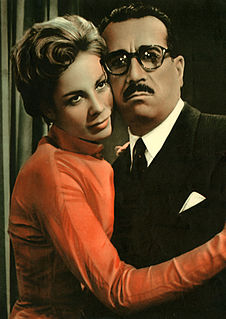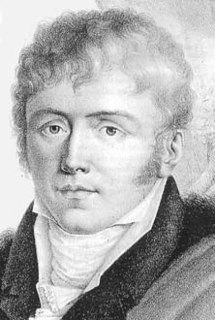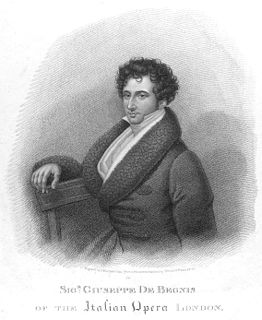
Domenico Gaetano Maria Donizetti was an Italian composer. Along with Gioachino Rossini and Vincenzo Bellini, Donizetti was a leading composer of the bel canto opera style during the first half of the nineteenth century. Donizetti's close association with the bel canto style was undoubtedly an influence on other composers such as Giuseppe Verdi.

Peppino De Filippo was an Italian actor.

Le convenienze ed inconvenienze teatrali, also known as Viva la mamma, is a dramma giocoso, or opera, in two acts by Gaetano Donizetti. The Italian libretto was written by Domenico Gilardoni, adapted from Antonio Simeone Sografi's plays Le convenienze teatrali (1794) and Le inconvenienze teatrali (1800).
Robert Merwald is a German baritone active in opera, oratorio, and lied, primarily in Germany and Austria.

William Victor "Bill" Gropper, was a U.S. cartoonist, painter, lithographer, and muralist. A committed radical, Gropper is best known for the political work which he contributed to such left wing publications as The Revolutionary Age,The Liberator,The New Masses,The Worker, and The Morning Freiheit.

Donato Giannotti (27 November 1492 – 1573) was an Italian political writer and playwright.
Giuseppe Farinelli was an Italian composer active at the end of the 18th century and the beginning of the 19th century who excelled in writing opera buffas. Considered the successor and most successful imitator of Domenico Cimarosa, the greatest of his roughly 60 operas include I riti d'Efeso, La contadina bizzarra and Ginevra degli Almieri. More than 2/3 of his operas were produced between 1800-1810 at the height of his popularity. With the arrival of Gioachino Rossini his operas became less desirable with the public, and by 1817 his operas were no longer performed. His other compositions include 3 piano forte sonatas, 3 oratorios, 11 cantatas, 5 masses, 2 Te Deums, a Stabat mater, a Salve regina, a Tantum ergo, numerous motets, and several other sacred works.
Farsa is a genre of opera, associated with Venice in the late 18th and early 19th centuries. It is also sometimes called farsetta.

Adina is an operatic farsa in one act by Gioachino Rossini with a libretto by Marchese Gherardo Bevilacqua-Aldobrandini. The opera develops the popular theme of the "abduction from the seraglio". The première took place on 22 June 1826 at the Teatro Nacional de São Carlos, Lisbon.
Gaetano Rossi was an Italian opera librettist for several of the well-known bel canto-era composers including Gioachino Rossini, Gaetano Donizetti, and Saverio Mercadante in Italy and Giacomo Meyerbeer in one of his early Italian successes. Other composers with whom he worked included Simon Mayr, a composer and Donizetti's teacher, as well as the prolific Giovanni Pacini.
Marcello Bernardini was an Italian composer and librettist. Little is known of him, save that he wrote 37 operas in his career. His father was most likely the composer Rinaldo di Capua.

L'amor coniugale is an opera in one act by Simon Mayr set to an Italian libretto by Gaetano Rossi. It premiered at Padua's Teatro Nuovo on 26 July 1805.

Una follia is a farsa in one act by composer Gaetano Donizetti. The work premiered on 15 December 1818 at the Teatro San Luca in Venice. The opera uses the same Italian-language libretto by Bartolomeo Merelli after August von Kotzebue's Der Graf von Burgund that Donizetti used for his Enrico di Borgogna a month earlier, but with different music. It was given one performance and "never performed again, and its score has never been found."

La lettera anonima is a farce in one act composed by Gaetano Donizetti in 1822 to a libretto by Giulio Genoino, a former monk and the official censor of the Kingdom of the Two Sicilies. Genoino based his libretto on his own farce which, in turn, had been based on Mélite, ou Les fausses lettres by Pierre Corneille in 1630.

Giuseppe de Begnis was an operatic bass singer. Born in Lugo di Romagna, he started his musical education when he was 7 years old, under Padre Bongiovanni, and sang soprano in the church. At age 15 he had serious problems with his voice and began studying acting under Mandini, a famous actor of the time. His father did not want Giuseppe to become a comedian and in due course the young man became a pupil of the composer Giovanni Morandi, the husband of the singer Rosa Morandi.

Chiara e Serafina, o I pirati is an opera semiseria in two acts by Gaetano Donizetti to a libretto by Felice Romani, based on the melodrama La cisterne by René Charles Guilbert de Pixérécourt. Donizetti's first opera for La Scala, it was premiered on October 26, 1822, but was not a success. Donizetti was not given the opportunity to compose again for La Scala until writing Ugo, conte di Parigi nearly a decade later.
Demetrio, Re di Siria is an 1823 Italian language opera by Mayr, staged in Turin. It was Mayr's last opera, followed only by the Oratorio Gioas in 1824. The libretto is a revision of Metastasio's 1732 libretto originally set by Hasse.
Giuseppe Maria Foppa was an Italian librettist. He wrote around 150 libretti, mainly for comic operas, as well as Latin oratorio texts and his memoirs.
Arianna in Nasso is an 1815 "azione drammatica", or scenic cantata in one act by Simon Mayr to a libretto by Giovanni Schmidt. It was premiered at the Teatro San Carlo, Naples, on 19 February 1815 with the role of Ariadne sung by Isabella Colbran who had requested Mayr to compose the piece for her to showcase her skills.









